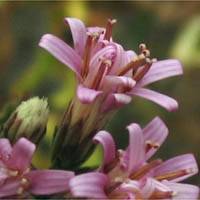Sacapellote facts for kids
Quick facts for kids Sacapellote |
|
|---|---|
 |
|
| Scientific classification | |
| Kingdom: | |
| (unranked): | |
| (unranked): | |
| (unranked): | |
| Order: | |
| Family: | |
| Genus: |
Acourtia
|
| Species: |
A. microcephala
|
| Binomial name | |
| Acourtia microcephala |
|
| Synonyms | |
|
|
Acourtia microcephala is a type of flowering plant. It belongs to the daisy family, just like sunflowers! People often call it sacapellote. You can find this plant growing naturally in southern California and Baja California. It likes to live in forests and chaparral areas, especially in mountains near the coast.
What is Sacapellote?
Acourtia microcephala is a bushy plant. It grows from a tough, woody base. This plant can reach about 1.5 meters (about 5 feet) tall. It has several stems that stand straight up.
Leaves and Stems
The stems branch out near the top. They are covered with many leaves. These leaves have jagged edges and a wavy shape. They are also glandular, which means they have tiny glands. Both the stems and leaves feel sticky. This stickiness comes from a special liquid called exudate.
Flowers and Fruit
The plant produces many flower heads in clusters. Each flower head is shaped like a cylinder. It is wrapped in long, flat, sticky leaves called phyllaries. These flower heads are discoid. This means they only have disc florets in the center. They do not have the petal-like ray florets that you see on a daisy.
Each disc floret has two parts, like lips. The outer part is long, flat, and usually bright pink. It can look like a petal! After the flowers bloom, the plant makes fruit. The fruit is a small, sticky achene. It is only a few millimeters long. Each fruit has a pappus, which is a tuft of bristles. These bristles can be up to a centimeter long. They help the seeds spread.
Traditional Uses
Long ago, people used this plant for medicine. It was used as a traditional laxative. This means it helped with digestion.

